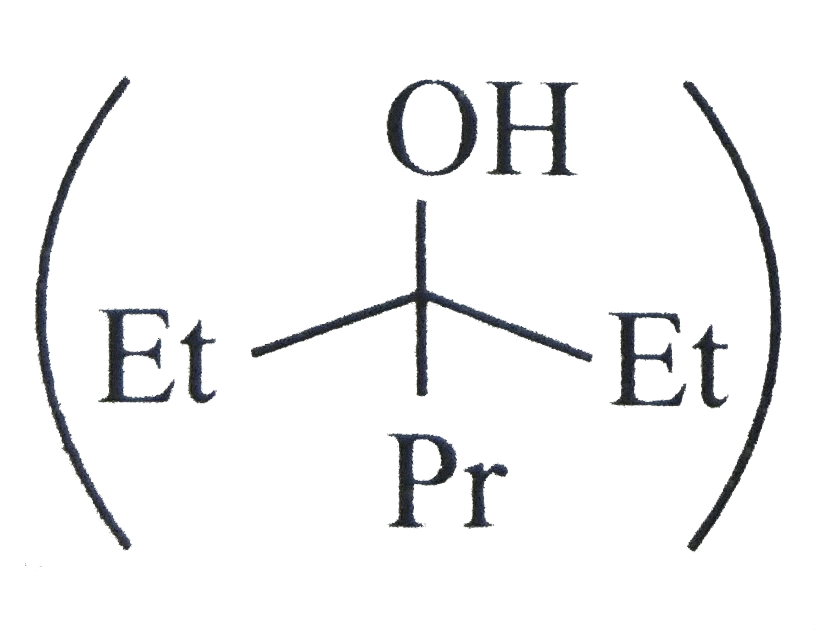Esters on reaction with EtMgBr give:
1∘ alcohols
2∘ alcohols
3∘ alcohols
Hydroxy ketone
The correct Answer is:B, C
To solve the question regarding the reaction of esters with ethyl magnesium bromide (EtMgBr), we will break down the process step by step.
1. Understanding the Reactants:
- Esters have the general structure RCOOR', where R and R' are alkyl or aryl groups.
- Ethyl magnesium bromide (EtMgBr) is a Grignard reagent, which is an organomagnesium compound. It can be represented as C2H5MgBr.
2. Mechanism of Reaction:
- The carbonyl carbon (C=O) in the ester is electrophilic, meaning it is susceptible to attack by nucleophiles.
- The ethyl group (C2H5-) from the Grignard reagent acts as a nucleophile and attacks the carbonyl carbon of the ester.
3. Formation of the Intermediate:
- When the ethyl group attacks, the double bond between carbon and oxygen in the carbonyl group breaks, leading to the formation of a tetrahedral intermediate.
- This intermediate can be represented as R-C(OH)(C2H5)-O-MgBr, where the oxygen now carries a negative charge.
4. Hydrolysis of the Intermediate:
- Upon hydrolysis (usually by adding water), the intermediate will decompose to form an alcohol and a magnesium salt.
- The final product after hydrolysis will be a tertiary alcohol (R-C(OH)(C2H5)2), where the carbon bearing the hydroxyl group is attached to three different groups (R, C2H5, and C2H5).
5. Final Products:
- The reaction of an ester with ethyl magnesium bromide ultimately yields a tertiary alcohol after hydrolysis.
Summary of the Reaction:
Esters react with ethyl magnesium bromide to form a tertiary alcohol after the nucleophilic attack and subsequent hydrolysis.
- Esters have the general structure RCOOR', where R and R' are alkyl or aryl groups.
- Ethyl magnesium bromide (EtMgBr) is a Grignard reagent, which is an organomagnesium compound. It can be represented as C2H5MgBr.
- The carbonyl carbon (C=O) in the ester is electrophilic, meaning it is susceptible to attack by nucleophiles.
- The ethyl group (C2H5-) from the Grignard reagent acts as a nucleophile and attacks the carbonyl carbon of the ester.
- When the ethyl group attacks, the double bond between carbon and oxygen in the carbonyl group breaks, leading to the formation of a tetrahedral intermediate.
- This intermediate can be represented as R-C(OH)(C2H5)-O-MgBr, where the oxygen now carries a negative charge.
- Upon hydrolysis (usually by adding water), the intermediate will decompose to form an alcohol and a magnesium salt.
- The final product after hydrolysis will be a tertiary alcohol (R-C(OH)(C2H5)2), where the carbon bearing the hydroxyl group is attached to three different groups (R, C2H5, and C2H5).
- The reaction of an ester with ethyl magnesium bromide ultimately yields a tertiary alcohol after hydrolysis.
Esters react with ethyl magnesium bromide to form a tertiary alcohol after the nucleophilic attack and subsequent hydrolysis.
Topper's Solved these Questions
- ALCOHOL,PHENOL AND ETHERSBOOK - CENGAGE CHEMISTRY ENGLISHCHAPTER - ALCOHOL,PHENOL AND ETHERSEXERCISE - Exercises Single Correct
72 Videos
- ALCOHOL,PHENOL AND ETHERSBOOK - CENGAGE CHEMISTRY ENGLISHCHAPTER - ALCOHOL,PHENOL AND ETHERSEXERCISE - Exercises Assertion-Reasoning
5 Videos
- ALCOHOL,PHENOL AND ETHERSBOOK - CENGAGE CHEMISTRY ENGLISHCHAPTER - ALCOHOL,PHENOL AND ETHERSEXERCISE - Exercises Linked Comprehension
60 Videos
- ALIPHATIC AND AROMATIC ALDEHYDES AND KETONESBOOK - CENGAGE CHEMISTRY ENGLISHCHAPTER - ALIPHATIC AND AROMATIC ALDEHYDES AND KETONESEXERCISE - Archives Subjective
26 Videos
Similar Questions
Methyl ester reacts with EtMgBr to give 3∘ alcohol
 The ester is :
The ester is :
View SolutionWhich of the following 3∘ alcohols does propyl ester give during reaction with EtMgBr ?
View SolutionThe reaction of
 with HBr gives :
with HBr gives :
View SolutionThe reaction of
 with HBr gives
with HBr gives
View SolutionEthyl ester reacts with PrMgBr to give 2∘ alcohol. The alcohol is :
View SolutionThe reaction of HBr with
 gives
gives
View SolutionHexan-3-one can be obtained by the reaction of EtMgBr and.
View SolutionWhen ethanamide is treated with EtMgBr, followed by hydrolysis, the product is :
View SolutionEster gives nucleophilic addition reaction followed by elimination reaction with carbon nucleopile. When carbon nucleophile is of an ester then the reaction is known as Claisen condensation reaction. This reaction is also carried out between ester and a ketone. A suC Cessful Claisen condensation requires an ester with two α− hydrogens and an equivalent amount of base rather than a catalytic amount of base.
Intramolecular Claisen condensation given diester is known as :
View SolutionEster gives nucleophilic addition reaction followed by elimination reaction with carbon nucleopile. When carbon nucleophile is of an ester then the reaction is known as Claisen condensation reaction. This reaction is also carried out between ester and a ketone. A suC Cessful Claisen condensation requires an ester with two α− hydrogens and an equivalent amount of base rather than a catalytic amount of base. Consider the given reaction
CH3−COOC2H5C2H5ONa−−−−−→C2H5OHenolate ionether(X)−−−−−−−−−−−→Claisen condensation Product
For the above reaction the most reactive ester is :
View Solution
